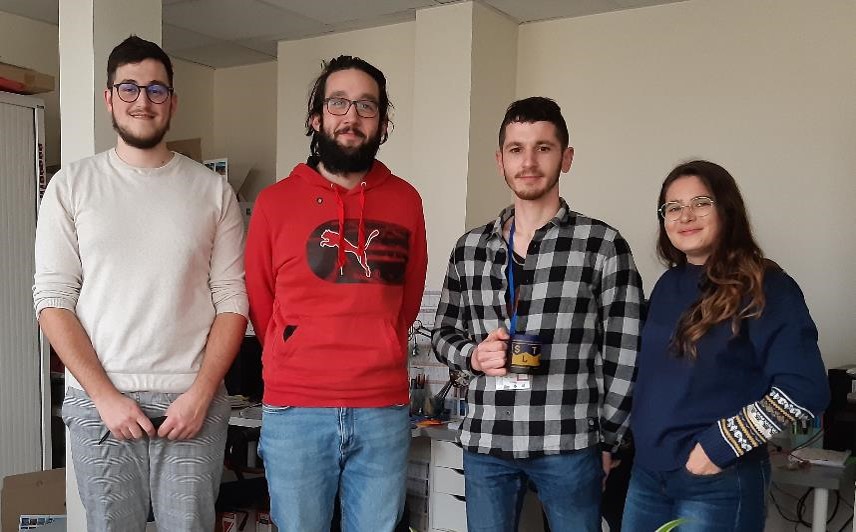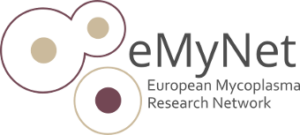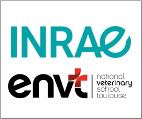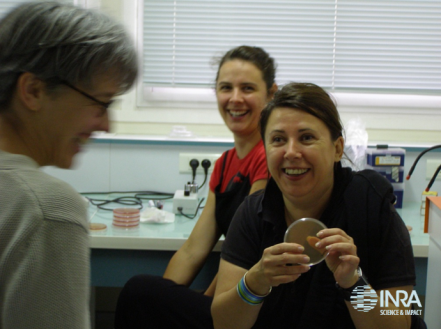Our group is part of a multidisciplinary research structure (UMR IHAP, INRA–ENVT) that integrates a broad expertise in fundamental research and veterinary science. The host-pathogen interactions unit develops global approaches aiming at understanding host-pathogen interactions at different levels of complexity, from the lab to the field.
From minimal cells to minimal pathogens
Mycoplasmas are minimal bacteria offering a simplified model to address a number of fundamental biological issues. Pathogenic species can in turn be seen as minimal pathogens, providing models that are both relevant and valuable for studying host-pathogen interactions. Our objective is (i) to understand how such micro-organisms with limited genetic resources are able to colonize, survive and adapt to complex hosts, (ii) to unravel the mechanisms underlying these events, and (iii) to foster innovative control strategies. To answer these questions, we have developed an integrative strategy that combines omics technologies to experimental models ranging from simple cell-based assay to the host. Our research focuses mainly on mycoplasmas species that are pathogenic for ruminants including Mycoplasma agalactiae and Mycoplasma bovis, two phylogenetically related species for which current control strategies are largely unsatisfactory.
Further readings
Perálvarez-Marín A*, Baranowski E*, Bierge P, Pich O, Lebrette H. Metal utilization in minimal bacteria: do human mycoplasmas rely on iron? Computational and Structural Biotechnology Journal. Computational and Structural Biotechnology Journal, 19, 5752-5761. (https://doi.org/10.1016/j.csbj.2021.10.022)
Mach N, Baranowski E, Nouvel LX, Citti C. The airway pathobiome in respiratory disease: a perspective in domestic animals. Frontiers in Cellular and Infection Microbiology. 11:583600 (https://doi.org/10.3389/fcimb.2021.583600)
Zhu X, Baranowski E, Dong Y, Li X, Hao Z, Zhao G, Zhang H, Lu D, Rasheed MA, Chen Y, Hu C, Chen H, Sagné E, Citti C, Guo A (2020). An emerging role for cyclic dinucleotide phosphodiesterase and nanoRNase activities in Mycoplasma bovis: Securing survival in cell culture. PLoS Pathogens. 16(6):e1008661. (https://doi.org/10.1371/journal.ppat.1008661)
Zhu X* , Dong Y*, Baranowski E, Li X, Zhao G, Hao Z, Zhang H, Chen Y, Hu C, Chen H, Citti C, Guo A (2020). Mbov_0503 Encodes a Novel Cytoadhesin that Facilitates Mycoplasma bovis Interaction with Tight Junctions. Microorganisms. 8(2):164. (https://doi.org/10.3390/microorganisms8020164)
Zhu X, Dordet-Frisoni E, Gillard L, Ba A, Hygonenq MC, Sagné E, Nouvel LX, Maillard R, Assié S, Guo A, Citti C, Baranowski E (2019). Extracellular DNA: A Nutritional Trigger of Mycoplasma bovis Cytotoxicity. Front Microbiol. 10:2753. (https://doi.org/10.3389/fmicb.2019.02753)
Citti C, Blanchard A (2013). Mycoplasmas and their host : emerging and re-emerging minimal pathogens. Trends Microbiol. 21:196-203. (https://doi.org/10.1016/j.tim.2013.01.003)
Baranowski E, Bergonier D, Sagné E, Hygonenq MC, Ronsin P, Berthelot X, and Citti C. (2014) Experimental infections with Mycoplasma agalactiae identify key factors involved in host-colonization. PLos One, 9: e93970. (https://doi.org/10.1371/journal.pone.0093970)
Skapski A, Hygonenq MC, Sagné E, Guiral S, Citti C, and Baranowski E (2011). Genome-scale analysis of Mycoplasma agalactiae loci involved in interaction with host cells. PLoS One, 6: e25291. (https://doi.org/10.1371/journal.pone.0025291)
Baranowski E, Guiral S, Sagné E, Skapski A, and Citti C. (2010). Critical role of dispensable genes in Mycoplasma agalactiae interaction with mammalian cells. Infection and Immunity, 78: 1542-51. (https://doi.org/10.1128/IAI.01195-09)
The open genome
Horizontal gene transfer (HGT), a driving force of bacterial evolution, was long thought to be marginal in mycoplasmas, whose evolution was long thought to be only driven gene losses. This dogma was recently challenged by recent studies indicating that mycoplasma genomes are highly mobile. Our objective is to further decipher mechanisms evolved by these minimal bacteria to access a considerable reservoir of genetic resources distributed among a vast number of species. By combining classical mating experiments to comparative and functional genomics, integrative and conjugative elements (ICEs) have been identified as pivotal in horizontal gene flows within and among mycoplasma species. Indeed, mycoplasma conjugation is not restricted to ICE transmission, but also involves the transfer of large chromosomal fragments that generates progenies with mosaic genomes. Besides providing a new frame to understand the acquisition and dissemination of new phenotype traits in mycoplasmas, our studies are expanding the concept of minimal cell to the broader context of flowing information.
Further readings
Dordet-Frisoni E., Vandecasteele C., Contarin R., Sagné E., Baranowski E., Klopp C., Nouvel L.-X., Citti C. (2022). Impacts of Mycoplasma agalactiae restriction-modification systems on pan-epigenome dynamics and genome plasticity. Microbial Genomics, 8 (5), 000829. (https://doi.org/10.1099/mgen.0.000829)
García-Galán A, Baranowski E, Hygonenq MC, Walch M, Croville G, Citti C, De la Fe C, Nouvel LX. Genome mosaicism in field strains of Mycoplasma bovis as footprints of in-host horizontal chromosomal transfer. Submitted to Appl Environ Microbiol. 88 (1), e01661-21. (https://doi.org/10.1128/AEM.01661-21)
García-Galán A, Nouvel LX, Baranowski E, Gómez-Martín A, Sánchez A, Citti C, de la Fe C. (2020). Mycoplasma bovis in Spanish cattle herds: Two groups of multiresistant isolates predominate, with one remaining susceptible to fluoroquinolones. Pathogens. 9(7):545. (https://doi.org/10.3390/pathogens9070545)
Citti C* , Baranowski E*, Dordet-Frisoni E, Faucher M, Nouvel LX. Genomic Islands in Mycoplasmas. Genes. 11:836. (https://doi.org/10.3390/genes11080836)
Dordet-Frisoni E, Faucher M, Sagné E, Baranowski E, Tardy F, Nouvel LX, Citti C (2019). Mycoplasma Chromosomal Transfer: A Distributive, Conjugative Process Creating an Infinite Variety of Mosaic Genomes. Front Microbiol. 10:2441. (https://doi.org/10.3389/fmicb.2019.02441)
Citti C, Dordet-Frisoni E, Nouvel LX, Kuo CH, Baranowski E. (2018). Horizontal Gene Transfers in Mycoplasmas (Mollicutes). Curr Issues Mol Biol. 29:3-22. (https://www.caister.com/cimb/v/v29/3.pdf)
Faucher M, Nouvel LX, Dordet-Frisoni E, Sagné E, Baranowski E, Hygonenq MC, Marenda MS, Tardy F, Citti C. Mycoplasmas under experimental antimicrobial selection: The unpredicted contribution of horizontal chromosomal transfer. PLoS Genet. 2019 Jan 22;15(1):e1007910. (https://doi.org/10.1371/journal.pgen.1007910)
Baranowski E, Dordet-Frisoni E, Sagné E, Hygonenq MC, Pretre G, Claverol S, Fernandez L, Nouvel LX, Citti C. The Integrative Conjugative Element (ICE) of Mycoplasma agalactiae: Key Elements Involved in Horizontal Dissemination and Influence of Coresident ICEs. mBio. 2018 Jul 3;9(4). pii: e00873-18. (http://mbio.asm.org/content/9/4/e00873-18)
Citti C, Dordet-Frisoni E, Nouvel LX, Kuo CH, Baranowski E (2018). Horizontal Gene Transfers in Mycoplasmas (Mollicutes). Curr Issues Mol Biol. 29:3-22. (https://doi.org/10.21775/cimb.029.003)
Dordet Frisoni E, Sagné E, Baranowski E, Nouvel LX, Blanchard A, Marenda MS, Tardy F, Sirand-Pugnet P, and Citti C. (2014). Chromosomal transfers in mycoplasmas: when minimal genomes go mobile. mBio, 5: e01958. (https://doi.org/10.1128/mBio.01958-14)
Dordet Frisoni E, Marenda MS, Sagne E, Nouvel LX, Blanchard A, Tardy F, Sirand-Pugnet P, Baranowski E, and Citti C. (2013). ICEA of Mycoplasma agalactiae: a new family of self-transmissible integrative element that confers conjugative properties to the recipient strain. Molecular Microbiology, 89: 1226-39. (https://doi.org/10.1111/mmi.12341)
Emerging vaccine strategies
Considerable progress has been made in understanding the genetic mechanisms underlying surface variability in wall-less mycoplasmas. These sophisticated mechanisms of antigenic variation are largely responsible for the lack of effectiveness of conventional vaccine strategies. The development of subunit vaccines against M. bovis infection in cattle was initiated in 2015 with the participation of our group in the EU project H2020 SAPHIR. Our strategy relies on the identification of conserved antigens in a highly variable pathogen. This project may contribute to the development of alternative control strategies to overcome the alarming rate of antibioresistance in pathogenic mycoplasma species.
Further readings
Citti C, Nouvel LX, Baranowski E (2010). Phase and antigenic variation in mycoplasmas. Future Microbiol. 5(7):1073-85. (https://doi.org/10.2217/fmb.10.71)
Ruminant hemoplasmas as emerging pathogens?
Hemoplasmas (hemotrophic mycoplasmas) are commonly infecting the erythrocytes of wide range of mammalian species. Two species are known to infect cattle, Mycoplasma wenyonii and Candidatus Mycoplasma haemobos. Although hemoplasma infections remain mostly subclinical, evocative inclusions in bovine erythrocytes have been observed in France (2014) in cattle presenting milk drops, anemia, edema of the limbs and the udder. The development of a highly specific PCR assay allowed us to confirm the first identification of a cattle hemoplasma in France and the first clinical case due to M. wenyonii. A survey has been initiated to provide a clear picture of the epidemiological situation.
Further readings
Nouvel LX, Hygonenq MC, Catays C, Martinelli, Le Page P, Collin E, Inokuma H, Schelcher F ,Citti C, Maillard R (2019). First detection of Mycoplasma wenyonii in France: Identification, evaluation of the clinical impact and development of a new specific detection assay. CIMID 63:148-163 (https://doi.org/10.1016/j.cimid.2019.01.010)

Newly born mycoplasmologists
Group leader
Lab members
Xavier NOUVEL
Marie-Claude HYGONENQ
Gwendoline POT
Hortensia ROBERT
PhD students
M’hamed DERRICHE
Maverick MONIE–IBANES
Post-doc
Joshua MALSA
Past members
Michel BOISSEAU
Eveline SAGNE
Xavier BERTHELOT
Sébastien GUIRAL
Laura FERNANDEZ
Elisa SIMON
Contact
eric.baranowski@envt.fr
Address
UMR1225 IHAP
ENVT
23 chemin des capelles
31300 Toulouse
FRANCE


